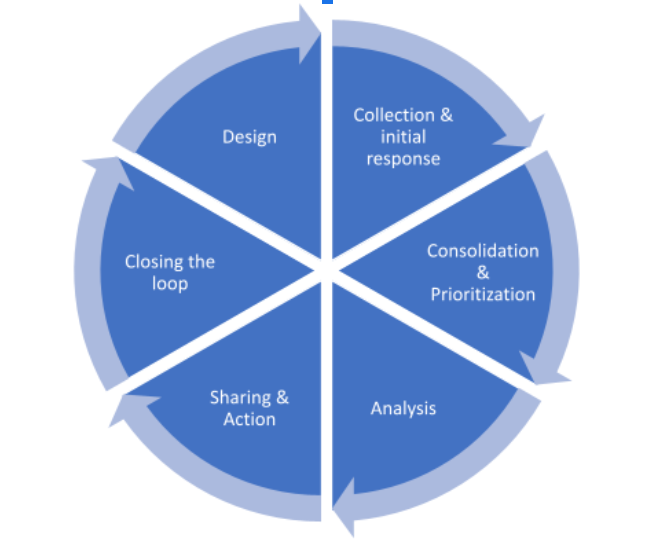Feedback Mechanism
Essentials on Feedback Mechanisms
What is a Feedback mechanism?
A feedback mechanism is a system to allow community members to provide information on their experience of the support they receive. the system enables the receiving, analysing, responding, and acting on community feedback, including questions, suggestions, observations, beliefs, perceptions, concerns, complaints and statements of thanks.

What is the difference between Feedback Mechanism and Feedback Channel?
(source: IFRC FEEDBACK KIT, 2022)
Feedback mechanism:
is a system that allows community members to provide information on their experience of the broader humanitarian system. This helps organisations be more accountable to communities and ultimately contributes to a better quality of programming. A feedback mechanism comprises the tools and processes to enable a complete feedback cycle. This means that it includes the channels for receiving feedback, the processes and tools for managing, analysing, and sharing the data, as well as the processes for ensuring the feedback is acted upon and communities are informed of the actions.
Feedback channel:
A feedback channel is a modality through which community insights can be shared, captured and received. By its very nature, each channel has its own characteristics that affect how accessible it is to certain individuals and groups in a community.
We can see that a feedback mechanism is the broader system that ensures a whole feedback loop, while the feedback channel is limited to the collection of the feedback. One feedback mechanism can, and should, comprise various different feedback channels.
Channels
Community insights can be shared, captured and received through various different channels. Every channel will be more or less accessible to different groups in a community, therefore only a combination of these can ensure the process is inclusive, and all community groups can be heard.
Community feedback can be collected through two type of channels:
Reactive or unsollicited feedback system where people come to us when they have feedback to share (e.g., a telephone hotline), or a proactive system,
Proactive or sollicited feedback system where we actively solicit feedback (e.g., focus group discussions).
Both are important and the best feedback mechanisms will use a mix of proactive and reactive methods. Both methods present advantage and disadvantage (see IFRC Feedback).
Find more about feedback system on the module 3.
Feedback are categorised as either open or structured, and which type is generated largely depends on the channel being used.
| Open feedback | |
| General description: | Listening to feedback from communities about community priorities |
| Feedback shared: | Formally and informally |
| Channels and activities for collecting this kind of feedback: | Community meetings, interactive radio shows, hotlines, discussions after community events, informal conversations during daily activities, etc. |
| Topics covered: | Any topic the community wants to comment on |
| Timing: | Open and varied, whenever community members want to share |
| Type of data generated by feedback: | Qualitative data |
| Useful for: | Understanding the thoughts and priorities of communities in real-time |
Find more about unstructured feedback in the Module 4
| Structured feedback | |
| General description: | Actively soliciting feedback from communities about specific topics |
| Feedback shared: | Formally |
| Channels and activities for collecting this kind of feedback: | Perception or Knowledge, Attitude and Practices (KAP) surveys, focus group discussions, key informant interviews, social media polls, etc. |
| Topics covered: | Topics pre-determined by aid organization |
| Timing: | Specific times pre-determined by aid organization |
| Type of data generated by feedback: | Qualitative data and/or quantitative data |
| Useful for: | Answering specific questions that can help to design programs, activities, and strategies |
Find more about Structured interview in the Module 5
Channels
Community insights can be shared, captured and received through various different channels. Every channel will be more or less accessible to different groups in a community, therefore only a combination of these can ensure the process is inclusive, and all community groups can be heard.
Community feedback can be collected through two type of channels:
Reactive or unsollicited feedback system where people come to us when they have feedback to share (e.g., a telephone hotline), or a proactive system,
Proactive or sollicited feedback system where we actively solicit feedback (e.g., focus group discussions).
Both are important and the best feedback mechanisms will use a mix of proactive and reactive methods. Both methods present advantage and disadvantage (see IFRC Feedback).
Find more about feedback system on the module 3.
Feedback are categorised as either open or structured, and which type is generated largely depends on the channel being used.
| Open feedback | Structured feedback | |
| General description: | Listening to feedback from communities about community priorities | Actively soliciting feedback from communities about specific topics |
| Feedback shared: | Formally and informally | Formally |
| Channels and activities for collecting this kind of feedback: | Community meetings, interactive radio shows, hotlines, discussions after community events, informal conversations during daily activities, etc. | Perception or Knowledge, Attitude and Practices (KAP) surveys, focus group discussions, key informant interviews, social media polls, etc. |
| Topics covered: | Any topic the community wants to comment on | Topics pre-determined by aid organization |
| Timing: | Open and varied, whenever community members want to share | Specific times pre-determined by aid organization |
| Type of data generated by feedback: | Qualitative data | Qualitative data and/or quantitative data |
| Useful for: | Understanding the thoughts and priorities of communities in real-time | Answering specific questions that can help to design programs, activities, and strategies |
Find more about unstructured feedback in the Module 4 and about Structured interview in the Module 5
Learn more
Find more guidance on Feedback Mechanism in the IFRC Feedback Kit 2022
What is the scope of the Tracker?
The Community Feedback Mechanism tracker is scoping feedback mechanisms through emergency responses and programmes:
Health:
COVID-19, Ebola, Dengue, Zika, Cholera and other
Disasters:
Cyclone, Volcano, Earthquake, Floods, Drought, and other
Conflicts:
Active conflict, Post-conflict, Complex situation
